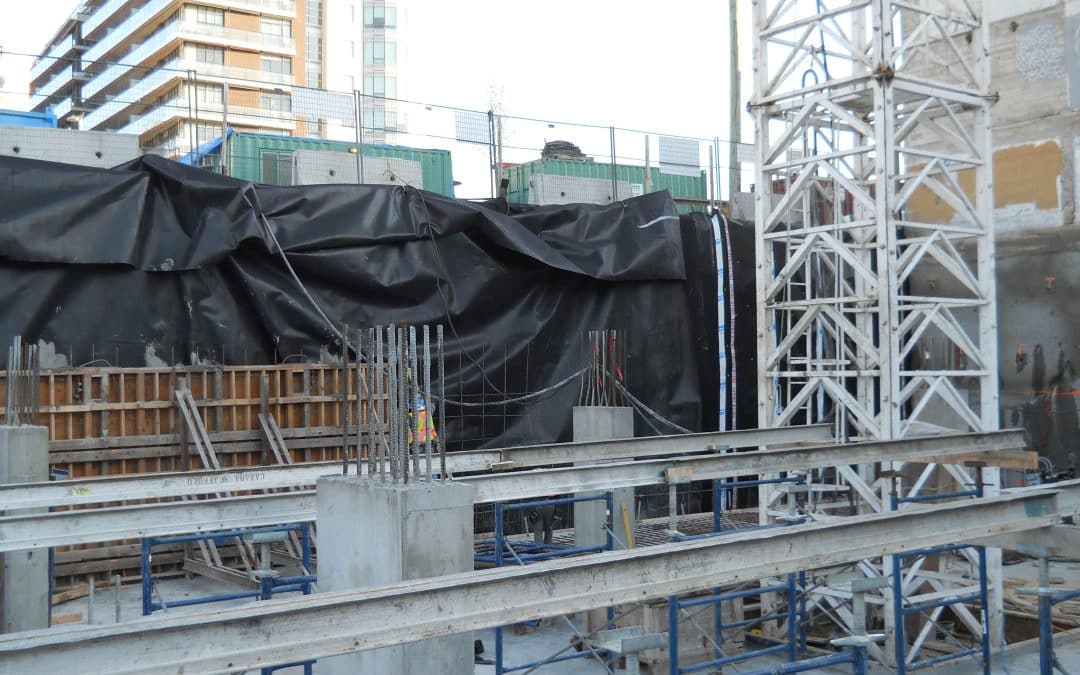This project included the completion of a Preliminary Site Investigation (PSI) Stage 1 and Stage 2, Detailed Site Investigation (DSI), Remedial Options Evaluation, off-site remediation, Human Health and Ecological Risk Assessment, and ongoing engineered barrier controls.
The potential for the contamination first came to light during a routine Stage 1 PSI conducted for the client as part of an asset management program. The source site, an electronics manufacturer, used trichloroethylene (TCE) for circuit board cleaning. Waste TCE was piped to a storage vessel located in the underground parking area of the building. Over the years, release of TCE resulted in both on and off-site soil, groundwater and soil vapour contamination.
With the pending construction of a new high-rise commercial and residential building across the street, there was an immediate need to determine if the contamination had extended to that property. The DSI was conducted to determine the extent of TCE contamination in the shallow (6 metres) and deep aquifers (10 metres below grade). The challenges with drilling were to prevent vertical migration of the TCE contamination. As a result, Prosonic Multi-case Override drilling methods were used to prevent vertical migration of dense non-aqueous phase liquid (DNAPL). The PSI and DSI consisted of over 50 monitoring wells.
The TCE plume had migrated onto City property and a property across the street, which at the time was being redeveloped. The TCE concentrations in some locations on and off-site were greater than 1% of its pure phase solubility, suggesting that DNAPL may be present.
Extensive hydrogeological investigations were subsequently completed in 2011 to provide support for the exclusion of drinking water standards for the site. Prior to conducting a remedial options evaluation, a Human Health and Ecological Risk Assessment was completed to determine the risk-based remediation targets. The combination of the exclusion of drinking water standards and risk-based targets allowed for a more cost-effective approach and expedited timeline, while not compromising the ecological or human health exposures.
With the contamination confirmed at the development property, a plan to remediate the developer’s property and secure a Certificate of Compliance (CofC) prior to their occupancy permit was required. This was complicated by the source site owner not wishing to undertake source remediation for several years; the existing building was intended to remain without site redevelopment for at least ten years. Keystone Environmental worked with the developer’s consultant to cooperatively advance remediation of the site and obtain a CofC
Remedial activities were conducted concurrently with redevelopment, and included the removal of approximately 9,000 tonnes of soil contaminated with TCE.
Since the source of TCE contamination was not to be remediated, a barrier wall was installed along the up‑gradient boundary of the redevelopment. With the dissolved TCE contamination within bedrock groundwater, the wall was designed as a collection/interception trench for groundwater and soil vapour and was installed from surface to approximately 11 m below surface. The TCE-contaminated groundwater is pumped back to the source site for treatment and discharged. Monthly monitoring of the treatment system, and quarterly sampling of monitoring wells down-gradient of the interception trench on the redevelopment property, confirm that the barrier wall is functioning as designed. A soil vapour extraction system was also installed to manage the potential for intrusion of vapours into the buildings.
The Human Health and Ecological Risk Assessment was used to support an application for a risk-based Certificate of Compliance.

